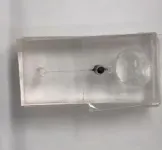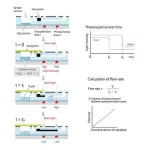Scientists deliver portable total chemical analysis without pumps and tubes
Flow driven by gas-producing reaction helps quantify compounds
2024-02-24
(Press-News.org)
Tokyo, Japan – Researchers from Tokyo Metropolitan University have engineered a new micro total analysis system that quantifies a target chemical in a microfluidic chip without pumps, tubes, and expensive detectors. The compound reacts with other chemicals to produce a gas, pushing ink in a connected chamber along a channel. Built-in light detectors help measure the flow speed, allowing measurement of the original chemical. The portability of the new device enables bedside, quantitative clinical analysis.
Microfluidics is a revolutionary technology delivering precision chemistry with vastly less chemicals. By etching thin channels and chambers into a compact chip that can fit into the palm of your hand, chemistry can be done with microliter amounts of liquid in a vastly parallelized array of reaction conditions, saving time, cost, and the environment. More recently, the quantitative detection of chemicals is also being incorporated into these miniature devices. These micro total analysis systems (micro-TAS) promise a complete chemical analysis that leverages all the benefits of microfluidics.
However, to drive flow around channels and chambers, microfluidics requires pumps, tubes to couple flow into channels, as well as expensive light sources and detectors to directly measure the optical signals that tell us how much of different chemicals are in our channels. This makes a method based on miniaturization and portability far less wieldy than originally proposed.
But now, a team led by Associate Professor Hizuru Nakajima from Tokyo Metropolitan University has come up with a whole new quantitation method that can get rid of the extra hardware altogether. They came up with a system where some compound of interest (analyte) produces a gas; the more analyte there is, the faster the gas is produced. This overpressure helps drive ink along a connected channel. As the ink flows along, it blocks room light reaching two organic photodetectors (OPDs) printed along the channel, helping to measure the flow speed. Since the light need only be blocked by a dark ink, the detection required is inexpensive and simple. Since flow is driven by gas production, there are no pumps, and no tubes.
They demonstrated their system by measuring the amount of C-reactive protein (CRP), a protein associated with an immune system response. Firstly, a CRP containing solution is added to a small chamber; the more CRP there is, the more attach to the specially treated walls of the chamber. Nanoparticles coated with CRP antibodies and catalase are then added; the more CRP there is, the more nanoparticles and catalase are left on the walls. When hydrogen peroxide is added, the catalase helps produce oxygen, completing the loop between analyte (in this case, CRP) and ink flow.
The team demonstrated that CRP concentration in human serum could be accurately detected, even in the presence of common proteins like immunoglobulin G (IgG) and human serum albumin. There was also good agreement with commonly available, far more hardware intensive methods. Given that the team’s new chip is easily portable, they believe it will see more application of micro-TAS in clinical diagnosis by the bedside or environmental analysis in the field.
This work was supported by JSPS KAKENHI Grant Numbers 21H03578 and 22K14709, the Tokyo Metropolitan Government, and the Tokyo Metropolitan Government Infectious Disease Research Project.
END
ELSE PRESS RELEASES FROM THIS DATE:
2024-02-23
“Given that the MET inhibitor capmatinib caused a remarkable response in Dr. Blagosklonny, a pertinent question remains as to why he was not treated with ‘preemptive drug combinations’ [...]”
BUFFALO, NY- February 23, 2024 – A new editorial paper was published in Oncoscience (Volume 11) on February 9, 2024, entitled, “A very long and winding road: developing novel therapeutics for metastatic tumors.”
In this editorial, researcher Paul Dent from the Department of Biochemistry and Molecular Biology at Virginia Commonwealth University writes that tumors that ...
2024-02-23
Physicians and scientists have known for many years that our genetics not only shape our physical features like our smiles but also our risk for developing certain diseases.
The problem? Most people don’t know if they have inherited these genetic risk factors for disease.
In Our DNA SC, a statewide genomic screening program launched by the Medical University of South Carolina (MUSC), aims to change that.
The program, the first and only program of its kind in the Southeast, is led by Caitlin G. Allen, Ph.D., a ...
2024-02-23
ARLINGTON, Va.—The Office of Naval Research (ONR) — and its international arm, ONR Global — participated in the recent Autonomous Warrior 2023 (AW23) exercise, located at HMAS Creswell in Jervis Bay, Australia.
AW23 brought together Australian military allies, as well as industry and international partners, to demonstrate various technologies designed to help the Royal Australian Navy strengthen its capabilities in the area of undersea warfare — including uncrewed (also called unmanned) and autonomous systems, artificial intelligence and machine learning, and logistics, ...
2024-02-23
Researchers have shown that the drug benralizumab is as effective and safe as mepolizumab for inducing remission in patients with eosinophilic granulomatosis with polyangiitis (EGPA) according to a study published today in The New England Journal of Medicine. The results of the non-inferiority study were presented at the American Academy of Allergy, Asthma & Immunology annual meeting in Washington, D.C., by Michael Wechsler, M.D., pulmonologist, director of The Cohen Family Asthma Institute at National Jewish Health and lead author of the paper.
EGPA is a rare form of vasculitis, characterized by inflammation in the small blood vessels. This inflammation ...
2024-02-23
An international team, including researchers from McMaster University and St. Joseph’s Healthcare Hamilton, has identified a new therapeutic for patients with a rare autoimmune disease called eosinophilic granulomatosis with polyangiitis (EGPA). A biologic drug called benralizumab has been shown to be non-inferior to mepolizumab in the treatment of EGPA.
In a clinical trial involving 140 patients with the rare disease, researchers directly compared two biologic drugs, mepolizumab and benralizumab. Patients received monthly subcutaneous injections of either 300 mg of mepolizumab or 30 mg of benralizumab for one year. The findings of the trial were published on Feb. 23, 2024, in the New ...
2024-02-23
Nitrogenases are considered promising candidates for the sustainable enzymatic production of ammonia and carbon compounds. Unfortunately, one bottleneck in this complex process, the supply of electrons to the enzymes, has remained a mystery until now. Now a team at the Max Planck Institute for Terrestrial Microbiology in Marburg has discovered two essential electron carriers which play a key role in determining the performance of iron (Fe) nitrogenase, thus opening up new possibilities for elucidating and maximizing nitrogenase's potential.
Nitrogenases are catalysts for several industrially relevant ...
2024-02-23
Machines still can’t think, but now they can validate your feelings, based on new research from New Jersey Institute of Technology Assistant Professor Jorge Fresneda.
Fresneda started his career as a chemist and then became an expert in neuroanalytics. He studies how measurements of brain activity and skin conductance can predict a person’s emotions with high accuracy, and how such information can be used in fields such as entertainment, management, marketing and well-being.
“Neuromarketing is a subfield within marketing ...
2024-02-23
ITHACA, N.Y. – Scientists have long believed that a newborn’s immune system was an immature version of an adult’s, but new research from Cornell University shows that newborns’ T cells – white blood cells that protect from disease – outperform those of adults at fighting off numerous infections.
These results help clarify why adults and infants respond differently to infections and pave the way for controlling T cells’ behavior for therapeutic applications.
This discovery was described in a paper published in Science Immunology on Feb. 23, co-led by Brian Rudd, associate professor of microbiology ...
2024-02-23
Understanding cloud patterns in our changing climate is essential to making accurate predictions about their impact on society and nature. Scientists at the Institute of Science and Technology Austria (ISTA) and the Max-Planck-Institute for Meteorology published a new study in the journal Science Advances that uses a high-resolution global climate model to understand how the clustering of clouds and storms impacts rainfall extremes in the tropics. They show that with rising temperatures, the severity of extreme precipitation events increases.
Extreme ...
2024-02-23
A new study has revealed that employees who are more mindful in the digital workplace are better protected against stress, anxiety and overload.
Researchers from the University of Nottingham’s Schools of Psychology and Medicine analysed survey data from 142 employees. The results have been published today in PLOS ONE.
PhD student Elizabeth Marsh from the School of Psychology led the mixed methods study and said: “As work is increasingly mediated by digital technology we wanted to find out the impact this is having on people’s health and whether there are ways to mitigate this. We found that being mindfully and confidently digital should be considered important elements ...
LAST 30 PRESS RELEASES:
[Press-News.org] Scientists deliver portable total chemical analysis without pumps and tubes
Flow driven by gas-producing reaction helps quantify compounds








